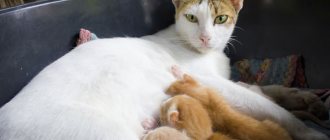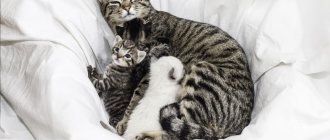What you need to know about Sphynx pregnancy
Mating of Sphynxes is almost no different from mating of individuals of any other breed. There are no peculiarities in the course of pregnancy either. There are only some differences in puberty and preparation for mating.
Puberty
Individuals of the Sphynx breed become sexually mature early. The first estrus begins already at 6–7 months of age. The behavior of a young female changes; she may become more affectionate or, conversely, more irritable.
But you need to understand that puberty does not mean the animal’s body is ready to mate. It is strictly forbidden to breed a female during her first heat, since there is a high probability of difficult childbirth and the birth of non-viable offspring.
Males become sexually mature later than females, at 8–9 months of age. The character of a young Sphynx cat also changes, becoming more arrogant and aggressive. The male begins to mark the territory. But you shouldn’t breed a cat, like a cat, too early; his body is not yet ready for mating.
Ready for mating
A female can become pregnant after her second or third heat. The optimal age for the first mating is 1.5 or 2 years, when the sphinx’s body is formed and the reproductive system is ready to work fully.
Search for a partner
It is important to find a suitable purebred male for the female. You should not mate a young cat for the first time with an inexperienced cat, for whom mating is also a new event, otherwise fertilization may not happen. It is better to choose an experienced gentleman for your pet.
Important! To ensure healthy offspring, it is important to breed hairless sphinxes with representatives of the velor (short straight coat) and brush (short curly) varieties. This reduces the likelihood of giving birth to kittens with genetic abnormalities.
Preparing for mating
The animals selected for mating have their claws trimmed to prevent injury during the mating process. You should not bathe pets, since it is by body odor that partners determine each other’s sexual attractiveness.
Before mating, animals must be vaccinated and anthelmintic treated. The period between vaccination and mating should not be less than 2 weeks.
Hormonal drugs that suppress the manifestations of estrus are stopped given to the cat several weeks before mating. If this is not done, then the hormonal background will not allow the Sphynx to become pregnant. And if the female becomes pregnant, then there is a high probability of giving birth to sick cubs.
Knitting process
The female is brought to visit the male. The owners leave the sphinxes alone, but periodically keep an eye on them so that the animals do not harm each other.
The optimal time for introducing pets is the 3rd day of estrus. The cat is left to stay with the cat for 2–3 days, since mating does not always occur on the first day, and if it does occur, the first sexual intercourse does not always lead to fertilization.
Recommendation! To ensure that your cat does not experience discomfort when visiting and feels its own smells, you should take with you its tray, bed and food bowl.
The sound sign of successful mating of sphinxes is the uterine rumbling of the male and the piercing cry of the female. After sexual intercourse, the male begins to lick himself, and the female lies down on the floor and begins to roll from side to side.
Is it possible to cross the Don and Canadian Sphynx?
Mating is unacceptable, because these are two different breeds, the standards of which do not allow admixtures of foreign blood. Their only similarity is the lack of fur. Such crossing does not make sense, since the resulting Sphynx hybrids will have no prospects.
Before giving birth, it is necessary to prepare the birth place
The simplest option is a spacious cardboard box, in which you need to make holes on the sides for additional ventilation.
The future place for the cat to give birth and the future life of the kittens must meet the following requirements: 1. open from the top, not from the side - this will make it more convenient for you to monitor the birth and change the bedding in the future; 2. When the top is closed, there must be an exit for the cat so that the kittens are closed, but the cat can independently go out about its business. Make a side exit for her, and this exit should not be from the floor, that is, it should have a kind of threshold - this will not allow blind kittens to accidentally crawl out of the box in the future.
Place clean diapers or sheets at the bottom of the box. It is recommended to cover everything on top with disposable diapers (available at the pharmacy) and then change them regularly. Place the box in the quietest corner.
As soon as the “hour X” comes and the cat begins to prepare a birthing place for itself: rummaging everywhere, climbing into or on cabinets, collecting material (pieces of newspapers) for the nest, then the first stage of labor has begun. Take her to the box, pet her, talk in a gentle voice, show her that the nest is ready for her.
Signs of pregnancy
A pregnant female Sphynx changes her behavior. A few days after mating, she begins to persistently caress her owner. Her appetite changes and she becomes capricious. It even happens that a pregnant cat refuses its usual and favorite food and demands something else. But there is no need to worry: the change in taste preferences is a temporary phenomenon.
Attention! Pregnant pet Sphynx eats a lot. If she refuses food, you should immediately take her to a veterinarian.
A pregnant Sphynx is aggressive towards other domestic animals, even humans. But this behavior is also temporary until the pregnant pet gets used to the changes in the body.
At the 3rd week, physiological signs of pregnancy become visible. The nipples swell and become lighter. A pregnant female gets fat. From the 4th week morning attacks of toxicosis may begin. From the 5th week, a pregnant Sphynx cat rapidly gains weight. Interest in males disappears, estrus is no longer observed.
Pregnant Sphynx cat: period, timing
Sphynx cats are one of the most unusual and extraordinary felines. An unconventional appearance, an easy-going character that you wouldn’t expect after the first meeting with a cat – all this awaits the happy owner. Pregnancy of the breed is a complex and responsible event that will bring a lot of joy and excitement.
A pregnant Sphynx requires special care and attention. Let’s dwell on such an exciting moment in more detail and try to make the owner’s life easier when the cat is in an “interesting position.”
Features of care
A pregnant Sphynx should not be left alone for long. During a difficult period, she becomes susceptible to stress and needs more care from her owner.
The Sphynx is fed special food for pregnant cats. Kitten food is also suitable. A pregnant cat should get enough proteins and minerals.
You should not let your pregnant pet go for a walk outside the house. Repeated accidental mating with a cat may occur, which will harm the embryos developing in the womb.
Attention! Any medications, including deworming medications, are given to a pregnant cat only after consultation with a veterinarian.
A cozy nest is built for the sphinx. A pregnant cat is not allowed to jump high or make fast movements. An accidental fall or impact may damage the embryos in the abdomen. To prevent a pregnant pet from becoming nervous, it is kept separately from other pets.
When the belly becomes large, it will be uncomfortable for the pregnant pet to lick itself. In this situation, the owner's help is needed. With a clean cloth moistened with warm water, you need to wipe the body of the sphinx in those places where it is dirty.
Aftercare for the animal
Mucous and bloody discharge from a cat’s genitals after birth is normal. If they do not stop after a week, you need to show the animal to a veterinarian. After labor is completed, you need to change the litter, then do this daily.
The owner must provide the new mother with care and concern. During the first day, the cat does not leave the nest, as it protects its offspring. You can place a toilet and bowls of food and water near the house so that the mother can recuperate. It is very important not to disturb the new family at this time.
Sphynxes do not like cool weather. You can put a warm heating pad in the nest and cover the box with a blanket so that the kittens do not get entangled in it.
Particular attention is paid to nutritious nutrition. Preference should be given to wet food for pregnant and lactating cats. The Sphynx also needs to drink a lot - fresh water should be available constantly.
The hardest part is over, but the worries don't end. To help a cat raise healthy offspring, there is still a lot of work to be done. Let them be pleasant!
False and frozen pregnancy
False pregnancy in sphinxes occurs when:
- hormonal disorders;
- intercourse with a neutered cat;
- stress exposure;
- mental disorder;
- disease of the reproductive system.
A falsely pregnant cat is fed low-calorie food and given medications that normalize hormonal synthesis. As a last resort, the Sphinx is sterilized.
Frozen pregnancy is observed in sphinxes when:
- hormonal disorder;
- inflammatory process;
- genetic abnormalities;
- stress;
- injury or pathological changes in internal organs.
If the ultrasound showed that some embryos survived, then the female sphinx is left pregnant. Dead babies come out during birth, just like live ones. If all the embryos have died, then they either wait for a miscarriage or use stimulation of the birth process.
Preparing for the event
Sphynx pregnancy lasts about two months - from 60 to 70 days. During this time, you should get used to the idea of expanding your family and prepare for the event. There is no need to worry about the process itself. As a rule, females cope with everything themselves. Sphynx cats have very well developed maternal instincts, so if the cat is healthy and has not had any problems during pregnancy, trust her. But there are points that you should take care of.
Location requirements
Cats are independent creatures and love to spend time alone and in silence. And during the birth process, cats generally have a special mental state, so they need peace and privacy. It would be better if it was a separate, quiet room. But you can select a secluded corner and put a special cat house in it or build it from a large cardboard box.
The best option is if it opens from the top, but has a small hole on the side so that the cat can get out to eat and go to the toilet. This hole should be located at such a height that small kittens cannot then accidentally crawl out of the box. You need to lay something soft inside to make it warm and comfortable. But cover it with disposable diapers (can be purchased at any pharmacy or children's store). These diapers are very soft, absorb moisture well and are easy to change.
As soon as you notice that the pet has begun to worry, look for a secluded place and drag soft things there, place it in the house and stay with it, gently talking and stroking it. This way the animal will calm down and understand that there is no need to look for a place anymore.
Materials and tools
Usually cats cope with everything themselves: they help the kitten to appear, lick it, and gnaw the umbilical cord. But you must be ready to join the process at any time and help your pet. Especially if she is giving birth for the first time.
Something else interesting: Rules for choosing a cat manufacturer
So, you will need:
- sterile medical gloves, which can be purchased at any pharmacy;
- sterile thread, disinfectant, scissors. You will need these tools if you need to cut the umbilical cord;
- small pipette or syringe: for sucking liquid from the nasal and oral cavity;
- clean soft napkins or pieces of cloth;
- Vaseline oil;
- artificial food: it is better to purchase a special one for cats, but as a last resort, for the first time you can get by with high-quality children’s food;
- if you want to monitor whether the baby is developing correctly, then scales, paper and a pen to record the weight;
- colorful ribbons: used to mark kittens. It is very convenient when artificial feeding or when there are a lot of babies, they help make sure that everyone eats.
In addition, it is better to make arrangements in advance with the veterinarian who cares for your cat in case of unforeseen situations.
Premature birth
It is not considered a pathology if the birth of a sphinx is a maximum of 5 days ahead of schedule or is delayed by the same amount of time. If the deviation from the optimal 9-week period is greater than normal, then urgent consultation with a veterinarian is needed, as the likelihood of giving birth to kittens with pathologies or non-viable ones increases.
Possible pathologies of premature or post-term Sphynx kittens and mother:
- uterine bleeding in a female;
- long labor, threatening the cat with loss of health;
- underdevelopment of the lungs, brain, nervous system in kittens;
- physical weakness of the cubs, inability to motor activity;
- lack of sucking reflex, leading to the death of kittens from hunger.
In order not to miss deviations from the normal period, the owner should keep a pregnancy calendar for the Sphynx pet.
The older the pregnant Sphynx female, the higher the likelihood of multiple conceptions. And due to the large number of embryos, the gestation period is shortened.
Prepare what you might need during the cat's birth.
- Special box for kittens (with heating pad). You can make it yourself from an ordinary strong cardboard box or purchase it at a pet store.
- Sterile surgical gloves.
- A pipette or syringe to remove fluid from the mouth and nose.
- Sterile thread.
- Antiseptic.
- Scissors.
- Clean towels.
- Vaseline oil.
- Phone number of a veterinarian who can urgently come to your home.
- Cat milk replacer.
- Scales
- Notebook, pen.
- As for medicines, it is advisable to buy gamavit (vetpeparat), calcium gluconate in ampoules, glucose, ascorbic acid, cardiac medications (cordiamin, caffeine, camphor), oxytocin. You shouldn’t use more serious remedies yourself; you could lose all the kittens and the cat.
How does childbirth occur in sphinxes?
The owner will know that a pregnant hairless cat is starting to give birth by certain signs:
- reducing the pet’s body temperature to 37 °C;
- the desire to lick the swollen vulva;
- release of the mucous mass that clogged the cervix;
- curvature of the spine;
- desire to hide in a secluded place.
The birth process for sphinxes consists of three stages:
- When contractions begin, bloody mucus appears from the vagina. The uterus contracts approximately every 30 minutes. The period from the initial contractions to the birth of the first kitten can take a day.
- The first kitten appears in the amniotic sac. The mother breaks the bladder, bites off the umbilical cord, and eats the afterbirth. Then he pushes the kitten towards his nipples.
- The remaining kittens appear. The next contractions are usually observed 10–15 minutes after the first. There are delayed contractions, when after the birth of the first calf, the next ones appear only after 15–35 hours. This is also the norm.
The mother should not be allowed to eat more than two afterbirths, otherwise it will negatively affect her hormonal levels.
When you need help
The owner must provide assistance when:
- The birth of the kitten occurred simultaneously with the release of amniotic fluid. You need to make sure that the cub does not suffocate. Shake him lightly, holding him head down. A live baby should make a sound similar to a sneeze.
- The cat did not free the cub from the bubble. You need to break the bubble, carefully wipe the kitten with a clean cloth, and use a pipette to remove mucus from the nose and mouth.
- The mother did not bite off the umbilical cord. It is necessary to clamp the umbilical cord with a thread and cut it with sterile scissors.
- The kitten was born weak, his breathing was labored. It is necessary to press lightly with your finger, massage the heart, and perform artificial respiration.
- The fetus is stuck inside the mother. You need to treat the cat’s vagina with Vaseline, twist a loop from a soft cloth, and use it to very carefully pull out the baby when the mother begins to push.
- The contractions are not intense. An injection of a stimulant drug must be given, but only after permission from the veterinarian.
You should find out the veterinarian’s phone number in advance so that you can call him immediately when your pet in labor begins to have problems.
Postpartum control
Look after your ward after giving birth. Cats especially need supervision in the first two weeks. Take your temperature every day - the normal temperature for Sphynx cats is 39.4 degrees. An increase in temperature may indicate the onset of an inflammatory process due to the placenta not being delivered. Or the beginning of the development of mastitis or metritis. In any case, you should call a veterinarian.
During the first week after giving birth, your cat will have reddish or dark green discharge. However, if the discharge has not stopped by the tenth day, this means that some kind of inflammatory process is going on in the uterus. If you notice such discharge by the 20th day, you should immediately call a veterinarian. Especially if the mucous membranes of the mouth and eyelids have turned pale, and the temperature is higher than normal.
First mating
The first mating for Canadian Sphynxes should be organized only after your pet is at least one and a half years old. At the same time, the cat will be completely ready for mating only after two, or even better, three heats. As for cats, the ideal age for the first mating is one and a half to two years, since only at this age the animal’s body has already formed. It should be noted that care should be taken to ensure that by this age both male and female cats have already received all the necessary vaccinations. Please note that under no circumstances should animals be vaccinated two weeks before mating.
Is it possible to influence the number of kittens?
This question is usually asked by cat breeders who sell kittens. After all, not only the expected profit directly depends on the number of offspring, but also covering the financial resources that were spent on mating with a good sire, tests, treatment, nurturing and feeding the future “money bag”.
Depending on the regalia of the male, the cost of mating can reach 10 thousand rubles. In most cases, owners of inseminators do not try to in any way influence the male health of their charges. Like we get money for mating, and then your problems: whether you got pregnant or not, how many kittens were born - it doesn’t concern us. This attitude is fundamentally wrong, and both sides should be interested in the offspring. Therefore, before you give money, ask:
- how often is a cat used for mating;
- is he eating well?
- does he have any diseases of the genitourinary system;
- how many kittens other cats bring from him;
- Does he suffer from cryptorchidism?
To increase fertility, many professionals advise injecting cats with:
- Ovariovit is a homeopathic drug, its action is aimed at restoring ovarian function, regulating the reproductive cycle and increasing fertility;
- Gamavit is an anti-stress, immunostimulating drug that supports the vitality of the body, and has a positive effect on eggs;
- Vitamin E – prevents infertility, has a positive effect on the reproductive system.
There is even a special scheme designed for 10 days:
- Ovarium (stimulates the protective function of the reproductive system) - half a cube is administered subcutaneously once a day;
- Ortilin (reduces the risk of inflammatory processes in the uterus) – one tablet twice;
- Ovariovit one tablet twice;
- vitamin E capsule twice a day;
- Gamavit one cube a day subcutaneously;
- Catozal (to normalize metabolism, increase immunity, resistance to stress) one cube per day subcutaneously.
Before putting any regimen into practice, consult your veterinarian!
Why does this work?
- Treatment may worsen estrus symptoms and increase hormone levels.
- At the same time, the cat becomes more attractive to the inseminator and is ready to attack the future father.
By the way, you can “stimulate” the cat by injecting him with B vitamins a couple of days before mating, which have a beneficial effect on the body’s endurance and activity.
Regarding the opposite effect (low fertility), there are no proven schemes as such. For example, there is an opinion that if after giving birth a cat with multiple births is left with only two kittens, then a certain switch is triggered in the body and the next time the animal will bring exactly two kittens. Although in practice, I personally have never observed such a phenomenon.
You can also do the opposite:
- poorly fed;
- keep under stress;
- exploit more often, forcing her to become pregnant every time she is in heat;
- periodically use hormones that inhibit the functioning of follicles.
In such living conditions, the body will quickly become exhausted and the cat will definitely stop giving birth a lot, if at all.
The process of mating cats
In most cases, mating of Canadian Sphynxes lasts no more than half a minute. She is accompanied by rather loud cries of a cat and a strong purring of a cat. Just at this moment, an egg is released from the cat's ovaries. However, fertilization does not occur immediately, taking about a day. In some cases, one mating is not enough for pregnancy to occur, and therefore both partners must spend a few more days with each other.
The most favorable time for mating of the Canadian Sphynx is the third to fifth day of estrus. This is explained by the fact that this is precisely the period when females ovulate.
If you look closely at the behavior of the Canadian Sphynx, it will be very easy to understand when mating has completed. Indeed, immediately after the end of mating, the female begins to roll on the floor, turning over on her back, and she can do this for a fairly long period of time. As for the cat, after finishing mating he strives for privacy and begins to wash himself and lick his fur.
How many kittens can a cat have in her lifetime?
Cats are characterized by high fertility; on average, from 3 to 8 kittens can be born in one litter.
How many babies can a cat have in her lifetime?
Over the course of her entire life, one female can give birth to up to 200 cubs. The record holder for the number of offspring was the outbred tortoiseshell cat Dusty from America, who gave birth to 420 kittens.
Modern medical technologies allow the owner to control the number and frequency of cat pregnancies, as well as facilitate the birth process. The main thing to remember is that the health of the pet and future offspring depends entirely on a balanced diet, conditions of detention and care.











